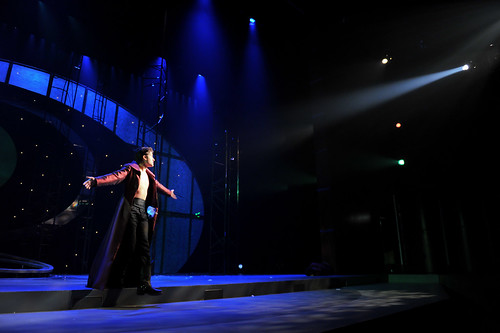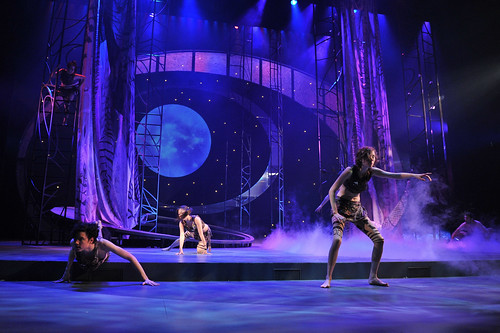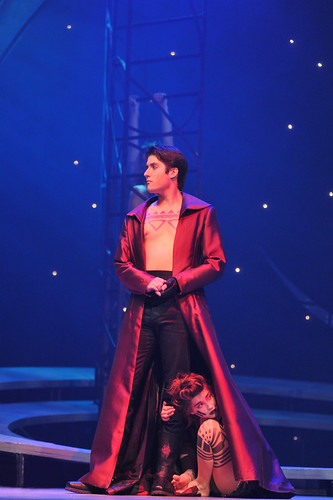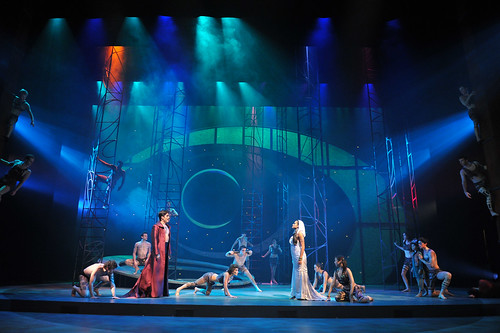So I’ve been shooting a lot of theatre lately – which, considering I work at a school for Theatre, is not the least bit surprising. More after the jump...
It started out innocently enough. Seven years ago when I took this job it was mostly as an excuse to afford a D100 (well, that, and an overwhelming desire to, you know, eat). I’m pretty sure food took a second place to a new camera body with that first month’s pay. Still; armed with a shiny new camera and a vast lack of knowledge, I was desperate for something, anything to shoot. Oh, and look here; I just happen to work for a place that every few weeks puts on performances which are just begging to be photographed. Ok then, let’s try that.
That was about 100,000 frames ago. The D100 became the D200; and then in a fit of counter-intuitive numbering became the D3. Last year alone I shot 7500 theatre pictures (and that’s just the keepers, and doesn’t include the 2 to 3X more that never made it past the delete key). Those kind of number probably don’t even register to a pro photographer, who in all likelihood release the shutter that many times before breakfast. But to me – and here I gleefully refuse attempts at self classification because you can’t fit me in your little box, man – it seems like a lot.
This week I got to shoot some tech rehearsals of a production of A Midsummer Night’s Dream. Fantastic sets, lights, and costumes. The production uses a lot of theatrical haze; great for wide shots, not so much for closeups. Theatre is probably the most challenging thing I shoot; everything (lights, actors, sets) are constantly changing and my fingers are dialing-in settings just trying to keep up. But at the end of the day (if I’m very, very lucky) I end up with a few shots that I just couldn’t get any other way.
If I may quote the preeminent philosopher of our age, Barbie; “Math is hard!” Yeah, well so is taking pictures of live theatre, Miss Malibu. Seriously, tho, I don’t know if it’s just here or a general trend in the theatre world; but theatre is insanely under lit. I know, I know; it’s lit for the eye and that’s what lighting designers are aiming for. But most of the time I’m at 60sec/f2.8 1600 ISO minimum; What, as they say, TF? The D3s is a fantastic help with this kind of stuff; but when I’m at 3200(!)ISO and *still* a stop & a-half under well, I want to speak to someone. I was under the impression that actors loved the Limelight; at least until I shot my first tech rehearsal. And (put’s down bottle and smoldering cigarette) don’t even get me started on white balance or exposure. Especially exposure...
This particular production lit just about all the actors with follow-spots. So most of the time their faces were at least two stops over the background. In the first picture the actors face and chest are completely blown-out. Does that make it a bad picture? I don't think so. But then again I cry a lot. Mostly alone.
Same thing here. Expose for the spotlight or expose for the subject? Oh, and you have about two seconds to make up your mind becasue that's how long this moment is going to last.
Still, all my bellyaching aside; where else do you get to walk into a room and have a full set, lights, subjects, and costumes just waiting to go. Is there a lot of technical BS you have to put up with? Yep. Do you have a lot of control over what is happening? Nope. But when you see those few pictures that you really dig you feel like you earned it.
A Midsummer Night's Dream
Directed by Don Wadsworth
Nov. 18th-20th, Nov. 30th - Dec. 4th, 2010
Click here for show info
Click here for tickets
End of line.






I'll give you that some shows are underlit, however the majority of what your experiencing has less to do with underlit shows and more to do with the difference in lighting between a studio setup, which most photographers are accustom to, and a theatrical approach to lighting. Not to get too technical, but the human eye is more sensitive to low levels, particularly light in the blue wavelengths (see scotopic vs. photopic vision). That's why blue light works so well. In addition, most lighting designers use a combination of "White" light and colored light, which can make it difficult to meter exact light levels. Anything will look underlit compared to a studio setup with softlights, strobes, speedlights, etc, white all create "white" light. But to say that we [lighting designers] underlight our work is essentially saying that we haven't done our job. It's like me saying to a more experienced photographer that his photos are under/overexposed. In the future I'd recommend phrasing it is a way that puts the emphasis on the shortcomings of the equipment - no matter how expensive it might be - and less on the designer, who made a conscious decision to light the scene to a level appropriate to the show and a live audience. Good lighting results in good photography... not the other way around. Now, SMB!
ReplyDeleteDid I mention your Midsummer shots are beautiful... cause they are. Nice job, Louis! NOW... SMB!
ReplyDelete